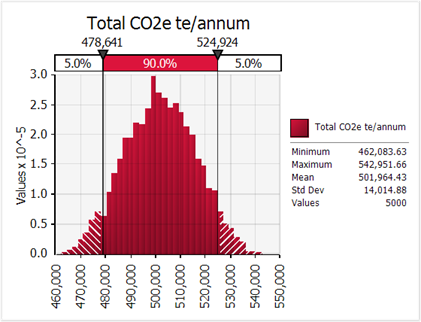Carbon Inventory Project Strategy
PROJECT GREENHOUSE GAS ASSESSMENT
SUMMARY
Siecap was commissioned to conduct a greenhouse gas assessment of Phase 1 of a proposed project suitable for inclusion in an Environmental Impact Statement (EIS).
OVERVIEW
The proposed project is a vertically integrated manufacturing facility with the ability to meet 100% of the resource requirements, as well as supplying nearby export markets in Australia and the South Pacific.
Phase 1 of the project involves the establishment of:
- a Quarry,
- Plant, and
- the construction of an export wharf.
APPROACH
To estimate the greenhouse gas emissions on the project, Siecap modelled the proposed operation using a quantitative model, applying the principles of probability management, which has its origins in “Monte Carlo” or stochastic simulation.
THE SOLUTION
The assessment was prepared in accordance with ISO 14064-1:2018 and the clients agreed Terms of Reference (ToR) for the proposed development in respect to Greenhouse Gas Emissions.
The relevant components of the agreed ToR were:
Provide an inventory of projected annual emissions for each relevant greenhouse gas, with total emissions expressed in CO2-e terms for the following categories:

Discuss the potential for greenhouse gas abatement measures, including:
- a description of the proposed measures (alternatives and preferred) to avoid and/or minimise direct greenhouse gas emissions,
- an assessment of how the preferred measures minimise emissions and achieve energy efficiency, and
- a description of any opportunities for further offsetting greenhouse gas emissions through indirect means, including sequestration and carbon trading.


THE EMISSIONS
Land based emissions were based on the outputs of the simulation model which provided utilisation of specific equipment and the quantities of required fuel for power generation and generation of thermal energy.
Marine based results included emissions from oceangoing vessels, barges, and tugs.
Only emissions occurring when tied up to berth and transhipping were included in the analysis.
Emissions were estimated based on fuel combusted in the vessels, both in the main engines for propulsion and in secondary engines for electrical power and other onboard services.
CARBON INVENTORY SERVICE
Siecap’s carbon inventory service is characterised by its ability to provide organisations with enhanced decision support and a better understanding of the complex characteristics and uncertainty of their operation’s setting.
By developing a logical, virtual representation of a proposed system or process, Siecap’s simulations enable the detail understanding of the nature and forecasted quantities of emissions.
CONCLUSION
As a result of Siecap’s assessment, the client has been able to identify new ways to reduce carbon emissions.
A range of measures have been included into the project development:
- Careful transport management and logistics planning to minimise truck movements,
- Procuring and specifying energy-efficient plant and equipment,
- Transitioning from Coal to Natural Gas in their procedures,
- Transitioning from diesel to natural gas in their power generation units,
- Incorporating a solar power development to displace diesel generated power, and
- Engaging with customers and suppliers to assess and address options for reducing the carbon impact of the products and services provided.
